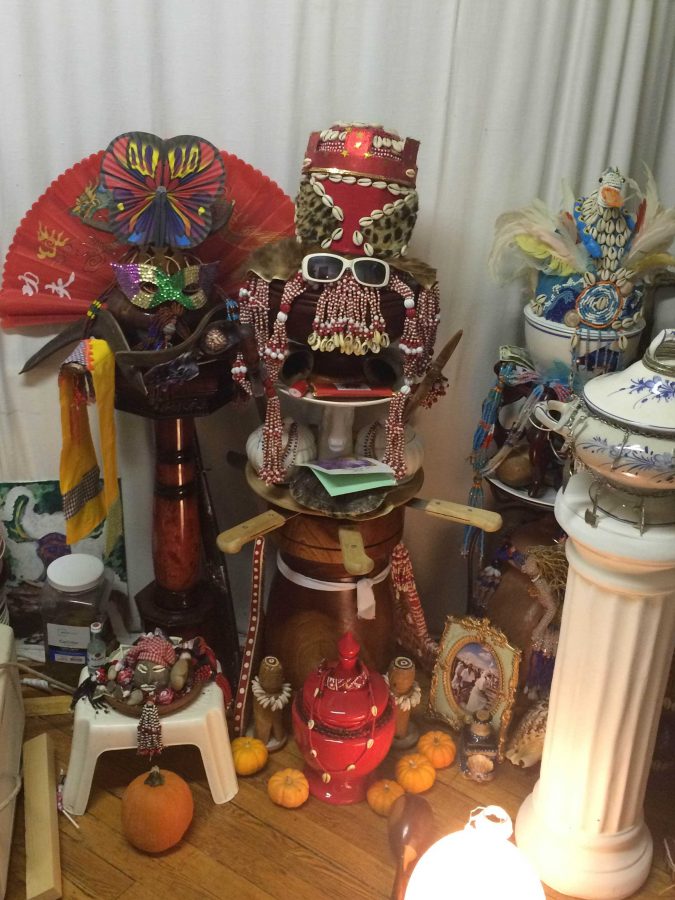By Alex Johanesen —
The white, square building is unassuming. If it wasn’t for the painted cat and dog mural on the exterior one would be liable to miss it. Trailers are built into the side but it is still petite, very unlike what the imagination contrives when it hears Liberty Humane Society. It could be an office, a construction site- anything but an animal shelter. Especially on a dark evening in late fall.
Inside it is crowded. The cats are in this room. So is the reception desk. Some interested adopters huddle there.
“Just don’t put your fingers in the cages,” smiles the receptionist, unsure if people are actually stupid enough to do it.
The green door opens. Barking erupts.
The walls of cages seem to vibrate. Each canine is housed in a confine big enough for its body. But that’s all its big enough for. A row of dogs on bottom. A row of dogs on top. Metal. The bars run from top to bottom of each cage.
The dogs don’t even have enough room to go to the bathroom without standing in it. The feces sits on the floor of the cage until a worker has time to remove the dog, clean out the crate, and usher the still barking animal back inside. And if no one is there to clean the cage? Then the dog has to wait.
 A blanket the thickness of a bath towel is laid out on the bottom of each cage. It’s just enough to cover the cold, frigid base.
A blanket the thickness of a bath towel is laid out on the bottom of each cage. It’s just enough to cover the cold, frigid base.
The barking doesn’t stop. The four littlest dogs visibly shake in their cages.
Shayne twists and turns in his. His silky tan mass is far too big for it. He’s an immense Pit Bull mix for a 1-year-old. He loves people- though it is difficult to see why.
“When he was a puppy he was thrown out of a pick-up.” A burly man working in the kennel shook his head. “My friend got him but his landlord said he couldn’t have him. Shayne’s been here for a while. I feel bad for this dude.”
The others all have their own stories. They shake, they bark, they growl. But nearly all have something in common. Most are some sort of American Pit Bull Terrier mixture.
Across the country, Pit Bulls and mixes make up 33% of the dog breeds. In cities it increases to 40-60%, and in some places, even higher.
One of the most popular breeds in the United States, yes. An undeserved villain? Very much so, thanks to the media’s thirst for a scapegoat and ignorant people’s assumptions. Especially when people group together every and any dog with similar traits under the one name of Pit Bull.
Pit Bulls are clouded by myth. They frequently attack humans. They are unpredictable. Their jaws lock. They feel no pain. In fact, their brains swell making them insane.
All lies.
Dog fighting was the American Pit Bull Terrier’s calling a century and a half ago. They were bred to be champions-to kill, or die, to please their owners. People-pleasing was stressed just as much as the fighting itself. If the dog bit its handler, it was killed. Before the fight, the owner of the opposing dog would give it a bath. If the dog was aggressive towards him, it was killed. If an injured dog showed hostility towards the veterinarian, it was killed. During that time the human-aggressive dogs didn’t make it.
According to the American Temperament Testing Society today, Pit Bulls have a higher score than Beagles and Golden Retrievers.
“They used to be called the nanny dog because they are so great with people,” stated Garber, a certified dog trainer and the head of the behavior department at the LHS. “Over the decades different dogs have come to the public eye because of the breed’s popularity. It happened to Dobermans, Rottweilers, now Pit Bulls.”
Because of their prevalence, Pit Bulls have become a type of dog that unknowledgeable people attempt to breed. Garber calls these backyard breeders. Bad breeding causes unreliability and mixes.
“Usually with a breed’s popularity the breeding standards tend to become less high. They disintegrate. So when breeding standards go down we tend to have less ambassadors of the breed.” Garber added, “And even though they’re popular people don’t understand their requirements or needs.”
This accounts for those particular dogs that have given humans fuel to hate the breed. However, behavior evaluations are the same for every dog at the Liberty Humane Society and Garber does notice a difference in Pit Bulls. But not the discrepancies most expect.
“All breeds have differences. I’ve noticed Pit Bulls tend to be high impact players with other dogs. They tend to be rambunctious when they’re young. They do things like jump on people. They need to learn impulse control but that’s also true for any young dog,” explained Garber.
Pit Bulls do not have a tendency to be nasty, violent, or unpredictable like some say. Instead, they are loving, energetic, and intelligent members of any family. So then, there must be a reason for these destitute dogs to be the most common breed at the Liberty Humane Society.
“Right now they’re a popular breed. That’s why they find themselves in the city. For instance, Jersey City itself has a dog fighting population and Pit Bulls are known for being bred for dog fighting. People, especially in more urban elements, are attracted to more muscular, mean looking dogs. That’s one of the reasons why there is an overpopulation of them here.” Garber goes on to add, “What also probably happens is people adopt puppies and they become adolescents, which are now bigger dogs and harder to handle. People are not quite as enamored with them because they haven’t done any training. They tend to surrender them to shelters because they don’t know what to do.”
That’s how Natty’s story begins.
In February, 2011 a young, lively Nay Nay was brought into the shelter. She waited patiently, learning the ways of the Liberty Humane Society and fitting cozily into volunteers’ hearts in the meantime. It took five long months for the two year-old Pit Bull Greyhound mix to get adopted. Her time of sitting in a cage hungering for full-time love was at an end. Or so she thought.
She was returned, like a toy nobody wanted for Christmas or a sweater that was too small. Not because she didn’t deserve the family, because she did. The family simply took on more than they could handle. Try explaining that to her.
“They had two babies and they also had adopted another dog from us. They brought in their dog to do a dog-meet and she got along great with him. But when they got home the couple saw the responsibility of the two dogs and the two babies. It wasn’t anything with her at all. She was great; it was just too much for their lifestyle,” said Daria Benstead, Volunteer and Event Coordinator at the Liberty Humane Society.
Disappointed staff decided her name, Nay Nay, might discourage adoption, so she became Nanette. Under the new alias everyone hoped she would find her forever home. But they are still waiting.
“I don’t know why she hasn’t been adopted yet. She’s extremely intelligent. Very lovable; she’s a great dog. I think a lot of people don’t like her brindle color. I think a lot of brindle dogs get overlooked.” Benstead sadly adds, “She’s our longest dog resident.”
Meanwhile, Nanette remained as cheerful as ever against the odds, occupying her time with agility tricks.
“She’s actually the best dog at our agility course,” claimed Benstead, who suggested seeing her perform at the Liberty Humane Society’s fundraiser Bark in the Park, October 16, 2011 in Hoboken.
Her chances of being adopted are slowly decreasing because of her age, now ascending towards three, her coloring, and her Pit Bull heritage. Everyone wants the cute little puppy not the older dog; even if she has mastered tricks most dogs can’t dream of. Even if she would love someone more than they ever imagined being loved.
And now, she has been moved to Hoboken Unleashed, a dog daycare and foster home.
“They wanted to know how she hasn’t been adopted yet,” said the receptionist at the Liberty Humane Society. “They absolutely love her.”
With the change, she has become Natty. No doubt another attempt at an adoptable name.
Some dogs do get the opportunity to have a place to call home, however. Some don’t need to be moved from place to place or try out a different name.
Rosie, a red-nose Pit Bull, resides with her owners in an apartment in Jersey City. The roommates, New Jersey City University students, adopted her from the Liberty Humane Society almost 2 years ago and she still holds their hearts.
“She listens, she’s easy to train. It takes only a few days for her to learn a trick. Rosie is very loving and she rarely barks.” Walter Skinner, a 21 year-old English major at the university, describes his dog with as much affection as one might describe his or her child. He can’t help but grin. Rosie seems to contradict all make-believe notions of what a Pit Bull is like.
“People are ignorant and prejudice. They’re great animals as long as you’re a great person,” Skinner explained.
But for many Pit Bulls, the products of over-breeding, dog fighting, and an uninformed public, there is no chance. The Liberty Humane Society houses such an abundance of them that it is extremely hard to imagine all of them free of their cages.
An estimated one million Pit Bulls are euthanized each year in America.
Shelters, under the restraint of poor funding and too many boarders, have to find ways to cope. Fundraisers are held. Events are planned. Volunteers join. Yet, it never seems to be enough. Even if one dog gets adopted there are ten more to take its place. Euthanasia is used to make room for more adoptable dogs and, although Pit Bulls are the most popularly bred dog in the country, they are not the most commonly adopted.
“The Pit Bull euthanasia rate in shelters is at approximately 93% on average. That means for every 100 pit bulls that are surrendered to the shelter, only 7 will survive. And that number includes owner reclaims of lost dogs,” according to happypitbull.com.
Click here to see Cop’s Best Friend
Luckily for Natty who was one of the longest tenants of the LHS, no one can see that as her future.
“There are too many people that love her that would not let that happen,” stated Benstead. Hopefully the move to Hoboken Unleashed catches someone’s eye.
Hundreds of Pit Bulls across the country are put to sleep every day. Victims of their own infamy. Others, like Natty and Shayne, sit and wait, avoiding death by needle. But it just might be harder to die alone.
At night, all the dogs in the daycare at Hoboken Unleashed go home to warm houses. Homes where they have toys, and family, hugs, and kisses. There might be a little boy who squirms into bed with his beloved dog and falls asleep nuzzled into its neck. His arm is wrapped around his best friend. Natty doesn’t get that, though. The lights go off, the workers go home. She sits in the dark wondering if there will ever be a night when she cries out and someone is there to hold her tighter.




